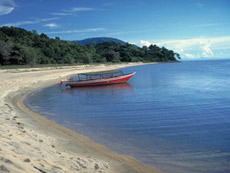Poverty, conflict, refugees and rapid urbanization were some of the problems affecting Central Africa’s Lake Tanganyika. WANI convened stakeholder meetings that led to a convention among the four countries bordering the lake. The convention formed a basin authority with a workplan to reduce poverty and promote sustainable management of the lake.
Burundi, Congo, Tanzania, Zambia
Lake Tanganyika, which covers 32,000 km2, is the second deepest lake in the world, reaching a depth of almost 1.5km. It is bordered by four countries: Burundi, the Democratic Republic of Congo, Tanzania, and Zambia. The lake is under pressure from rapid and uncoordinated urbanization, civil insecurity resulting from large numbers of refugees, and changing patterns of land tenure and land use – all contributing to environmental degradation. These pressures have lead to increased nutrient and sediment loads, industrial pollution, deforestation, overexploitation of fish stocks, invasive plant species and habitat destruction. To tackle these problems, the four shoreline countries needed to work together.
WANI worked with a consortium of partners –The African Development Bank, the UN Food and Agriculture Organization and the UN Development Programme and the Global Environmental Facility – to support development of a new transboundary basin authority. WANI convened two preparatory meetings and a Conference of Ministers meeting, which resulted in the signing of the Convention on Sustainable Management of Lake Tanganyika by the four governments and formal establishment of the Lake Tanganyika Authority (LTA). The mission of the LTA is to reduce environmental threats to the lake ecosystem, while promoting sustainable development and poverty eradication in the basin. To help put the agreement into practice, WANI facilitated management committee meetings in which agreements were reached on establishing a headquarters and nominating a Secretariat. Later, WANI helped develop a workplan for the LTA. In 2007 a study was undertaken to evaluate the lessons learnt in transboundary basin management in Africa. This contributed to the WANI toolkit SHARE, which gives an overview of the world’s shared water resources and guidance on managing these cooperatively.
In recent years the Lake Tanganyika Authority has continued to develop joint actions with countries bordering the lake. The Strategic Action Plan was updated in 2010. Efforts to establish a Framework for the Lake Tanganyika Regional Integrated Environmental Monitoring Programme are also ongoing. Regional workshops continue to be held on concerns affecting the lake such as fisheries, invasive species and climate change.
Resources:
